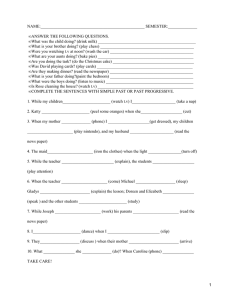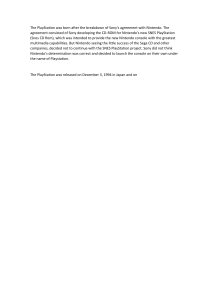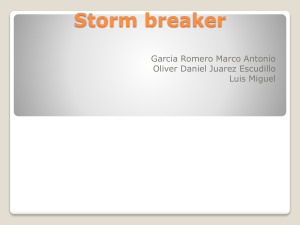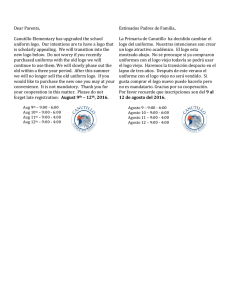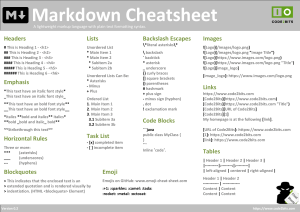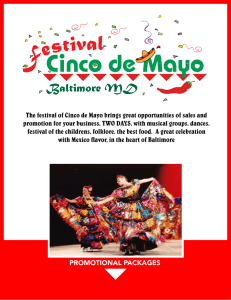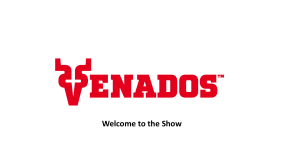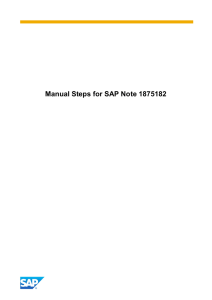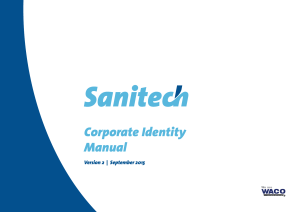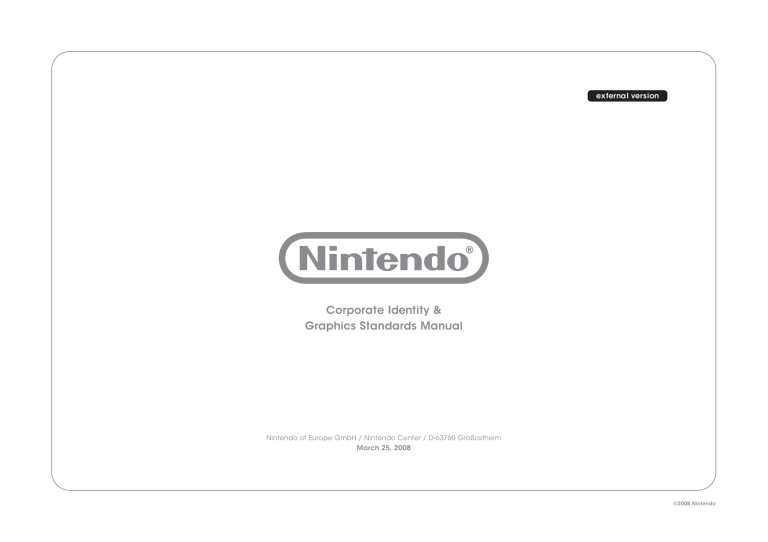
external version Corporate Identity & Graphics Standards Manual Nintendo of Europe GmbH / Nintendo Center / D-63760 Großostheim March 25, 2008 ©2008 Nintendo Introduction Table of Contents From the bir th of the video game industry to • What Is The Purpose of This Manual? 1 • How To Use and Protect Our Trademarks and Copyrights 2 • History of The Nintendo Logo 3 • Our Legal Corporate Name and Trademark 4 • 1. Proportion and Protective Area 5 • 2-1. Corporate Logo Color 6 • 2-2. Grayscale Backgrounds 7 • 3. Color Backgrounds 8 • 4. Prohibited Use 9 present day, Nintendo has continued to create unique products intended for everyone, and established a brand that is known throughout t h e wo r l d a n d i s s y n o ny m o u s w i t h g a m i n g culture. Our mission is to continue to create intriguing new ideas, and to bring smiles to our customers everywhere-without regard to age, gender, nationality, or culture. W h i l e N i n te n d o c o n t i nu e s to i n n ova te , i t i s i m p o r ta n t to c o n s i d e r h ow we a p p e a r to customers throughout the world. T h e N i n te n d o c o r p o ra te l o g o s e r v e s a s a representation of a brand image. The handling of a logo that is seen by customers, with unified s ta n d a rd s a n d c a re f u l m a n a g e m e n t , w i l l accurately transmit our corporate sincerity and quality to people everywhere. Doing so will also lead to trust from our customers. • 5. Corporate Logo Applications 11 • Product Graphics Standards 13 Hardware Packshots 14 Software Packshots 15 Logo Example 17 T h e s e g u i d e l i n e s c o n ta i n u s a g e r u l e s a n d s ta n d a rd s f o r u n i f y i n g t h e N i n te n d o l o g o throughout the world and putting it to use. We ask for the cooperation of everyone in having a thorough understanding of the purpose of this manual and making use of it. Nintendo Corporate Identity & Graphics Standards Manual What Is The Purpose of This Manual? Nintendo has an international presence, Misuse of our trademarked logos and logo- with subsidiaries worldwide. types weakens Nintendo’s ability to protect our trademarks and reserve them exclusively Because of this, it is impor tant to have a for our use or the use of whomever we deem unified corporate identity program to help appropriate. maintain a consistent and correct corporate look throughout Nintendo. • Presents the corporate identity program and how to apply it. • Describes how to use trademarks. Even slight var iations, modifications or embellishments can damage Nintendo’s Many different businesses produce products This manual provides the following information: claim to these trademarks. • Gives rules and standards on how to apply our trademarks in various applications. using our trademarks. • Gives color and graphic standards for It is also important to have a set of standards Nintendo’s products. and rules so that all of our products will have a consistent family look about them and will • Provides a reference library of our trade- use our trademarks consistently and correctly. marked graphics. Almost everyone has a computer on their desk capable of manipulating graphics. These standards and rules will ensure that everyone using our trademarks will do so consistently and correctly. To protect our legal rights to our trademarks, they must be used correctly. 1 Nintendo Corporate Identity & Graphics Standards Manual How To Use and Protect Our Trademarks and Copyrights A trademark is a word, name, symbol or logo • Trademarks are not plural or possessive in that identifies the product of a company. Our for m, and should not be abbreviated, trademarks must be protected or we will lose unless the abbreviation is also a trademark. the right to control them and keep them exclusively for our own use. • Trademarks should be distinguished from common words by print style and capital- Below are some simple rules for using our ization. more common trademarks for Europe. Nintendo® Game Boy Advance™ Nintendo GameCube™ Mario Bros.™ Super Mario Bros.™ tradename and trademarks. • Nintendo product packaging and market• Each registered Nintendo trademark must Here is an abbreviated list of some of our ing materials must include the proper have a ”TM” , ”SM” or ”®” after the first use copyright notice. or most prominent use in a single publica- Typically, this would be something like: tion, and must be properly acknowledged. ”© (date) Nintendo.” Donkey Kong™ Metroid™ The Legend of Zelda™ Super Mario World™ Wii™ Nintendo DS™ Lite • The trademark ”Nintendo® ” should not be In addition to these trademarks, there are confused with our corporate name. ”Nintendo” many more for additional hardware accesso- is used as an abbreviation for the com- ries, trademarks for hundreds of game titles pany name, ”Nintendo of Europe GmbH.” a n d m a ny fo r s u c h t h i n g s a s m a r ke t i n g The trademark is used for brand name slogans like Wii™ move you. identification, as in ”We sell Nintendo ® brand video games.” • There is no such thing as a Nintendo. Be careful to use the Nintendo brand name as an adjective, not as a noun. 2 Nintendo Corporate Identity & Graphics Standards Manual History of The Nintendo Logo Th e fir s t roman iz ed Nin ten do logo u s i n g the font style associated with the current ”racetrack” design was in 1959. This logo was modified several times over the years, but continued to retain the basic form still in use today. 1959 - The text style is changed to a non-cursive style. 1995 - The current logo is a little bolder and the racetrack fits tighter around the text when compared to the earlier version. 1984 - The ”racetrack” is added. 2008 - Worldwide logo color is changed from red to gray. When Nintendo began manufacturing the Game & Watch ® product in the early 1980s, the logo was applied as a label inset into the plastic housing and a racetrack shape was added to define the logo. Most products manufactured after 1984 continued to use this racetrack shape around the logo and soon Nintendo Company Ltd. and its subsidiaries were using this design on most applications, including consumer products and advertising. As Nintendo developed into a worldwide company, new variations in the logo design came into use. In 1994 it was decided to converge the various logos into one design, and establish a new unified look. In 2008, the logo color was unified globally from the original red color to gray. Make sure that you are using the latest version of the Nintendo logo. 3 Nintendo Corporate Identity & Graphics Standards Manual Our Legal Corporate Name and Trademark O u r c o m p a ny ’ s f u l l a n d l e g a l n a m e i s Make sure that you are using the latest Nintendo of Europe GmbH. This is the way that version of the Nintendo logo. Nintendo of Europe GmbH the company name should appear in most formal or legal documents. It is important to use our logo in a consistent The correct legal name in AvantGarde Bold font style. and correct manner, based on the guidelines In general or informal use, the name Nintendo set down in this document. This will help us alone is appropriate. In bodies of text or other achieve the following goals: Nintendo instances where the name of the company may appear more than once, the full name should be used the first time it appears and • Protect our rights to ownership and use of The correct informal name in AvantGarde Bold font style. our logo. then the informal name can be used after that. • Maintain our reputation for high quality, high value products. The Nintendo logo is our primary and most well known trademark. Information on proper and improper use of this logo is given in the • Maintain a positive and strong image that The correct corporate logo. is instantly recognizable. next section. • Reinforce our individuality and credibility. • Project the universality of our company Obsolete logo no longer in use. DO NOT USE! and products. 4 Nintendo Corporate Identity & Graphics Standards Manual 1. Proportion and Protective Area The Nintendo corporate logo includes the text logotype and the racetrack. The logotype mu s t a l wa y s b e u s e d to g e t h e r w i t h t h e racetrack. When displaying the corporate logo, a certain protective clear space should be maintained, and no other logos, text or graphic elements are allowed within this surrounding area. The size of the protective area around the logo is the same as the height and width of 10 100 % % 10 % t h e " n " o f t h e l o g o t y p e. E x p re s s e d i n numerical values, the margins at the left and 35 % 100 % 35 % right should each be 10% of the logo's width, a n d t h e m a rg i n s a t t h e to p a n d b o t to m should each be 35% of the logo's height. 5 Nintendo Corporate Identity & Graphics Standards Manual 2-1. Corporate Logo Color The preferred logo colors are shown on the right. Gray is the standard color, followed by white, and black, in that order. Gray Standard color On a white background, use gray. On a color CMYK : K 50% background that decreases the visibility of RGB the gray logo, use white. Only in cases where : R 140 + G 140 + B 140 PANTONE Cool Gray 8c the visibility of white logo is low, then the black color may be used. Examples of the gray, white, and black colors are shown in section 2-2. White Black CMYK : C 0% + M 0% + Y 0% + K 0% CMYK : K 100% RGB RGB : R 255 + G 255 + B 255 6 : R0 + G0 + B0 Nintendo Corporate Identity & Graphics Standards Manual 5. Corporate Logo Applications TV Commercials & Promotional Videos Game Software Events (Large-scale events aimed at transmitting information worldwide, etc.) 12 Nintendo Corporate Identity & Graphics Standards Manual Product Graphic Standards 13 Nintendo Corporate Identity & Graphics Standards Manual How To UsePackshots and Protect Our Trademarks and Copyrights Hardware 14 Nintendo Corporate Identity & Graphics Standards Manual Software Packshots 15 Nintendo Corporate Identity & Graphics Standards Manual Software Packshots 16 Nintendo Corporate Identity & Graphics Standards Manual Logo Example 17 Nintendo Corporate Identity & Graphics Standards Manual
